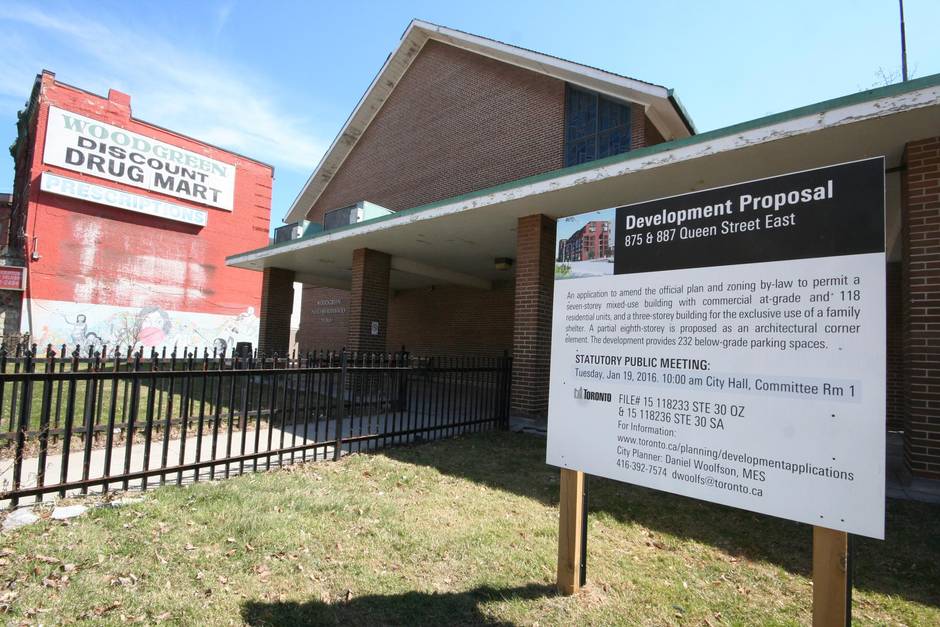A little bit of Leslieville will live on in new Queen East condo
Heritage architecture is kind of like cool jazz. Almost everyone claims to dig it – put on Brubeck’s “Take Five” and you’ll get a room full of tapping feet – but everyday clubs have trouble finding bums to fill seats.
Similarly, while everyone gets worked up over threats to significant landmarks, who’s there when the little buildings, the architectural sidemen if you will, are about to disappear?
Shiralee Hudson Hill is there.
It all started, she says, after a celebratory community meeting that her husband, Matthew Hill, attended in March 2015. After months of negotiation and a fight led by city councillor Paula Fletcher, the Red Door Family Shelter at 875 Queen St. E. in Leslieville had been saved; Harhay Developments would give it a new home in the condominium that would replace the 1958 WoodGreen United Church.
But the architectural drawings on display had left something out: the workaday but very interesting 1888 building at the corner of Logan Ave. – home to Woodgreen Discount Drugs for decades – wasn’t part of the plan. Too expensive to rehabilitate, Mr. Hill was told.
“So, that night, I started e-mailing historical societies – the Riverdale and the Leslieville Historical Society – and saying “this is what’s happening,” says Ms. Hudson Hill, who works as an interpretive planner at the Art Gallery of Ontario.

Moreover, she joined the Leslieville group, which had formed in December, 2014, to prepare for a fight. Using information from local historian Joanne Doucette, she prepared a flyer, “Save Leslieville’s Heritage,” that detailed the building’s history. To wit: 887 Queen St. E. was the area’s first medical building; the land was owned by butcher and city alderman Edward Blong (there’s a Leslieville street named after him); Burgess Drug Store and the office of Dr. John A. Burgess and were the building’s first tenants; and, finally, a Toronto Heritage Preservation Services report from February, 2014, stated that the building “retains many fine features,” such as a pressed tin cornice, and merited “further investigation.”
Cool. But things went “dormant” until July 2, when the first community meeting was scheduled.
Before showing up with a stack of flyers, however, Ms. Hudson Hill made Ms. Fletcher and the Red Door people aware of the LHS’s plans. “We wanted people to know this wasn’t an anti-Red Door campaign, that we were Red Door supporters,” she explains. This was also necessary, she adds, because through-the-grapevine chatter was hinting that asking the developer to save a heritage building – one the LHS admitted to being in “rough shape” – in addition to the family shelter might be asking for too much.
“But we didn’t think it had to be an either-or situation,” Ms. Hudson Hill says.

The strategy worked: “We went into that meeting and everyone was talking about saving the Red Door, which is an important conversation, but coming out, people were talking about saving heritage,” she beams. Even better, councillor Fletcher attended a meeting of the LHS to offer her support later that month.
Working now as a trio with her husband and LHS secretary Ted Radlak, a former Vaughan urban planner, Ms. Hudson Hill continued to build local support from her home base on Empire Ave. via a facebook group. In October, a meeting with Chris Harhay, president of Harhay Development, was set up by Ms. Fletcher’s office.
“He’s like a lot of developers in some ways – he wants to get the job done,” Ms. Hudson Hill says, “but he was also very willing to meet with us.”
Mr. Harhay presented the LHS with three scenarios: A full demolition and “replication” of the newly christened “Burgess Building” using modern materials, which was met with disapproval; an in situ retention of the façade, which was costly; and, finally, a catalogued dismantling of the façade with reconstruction once the new building was up, which was Mr. Harhay’s preference.

“We knew because of the Red Door factor that we were never going to save the entire building,” explains Ms. Hudson Hill, “and we’d seen [façade retention] done in many projects in Toronto and we thought it was a realistic ask.”
While in situ was the preferred option, the LHS went with Mr. Harhay’s choice when told that heritage superheroes ERA Architects were now on the job for the dismantling and reconstruction.
(As an Architourist’s aside, a façadectomy is a fine solution here. The ground floor retail space is quite utilitarian on the inside, with no remaining nineteenth century detailing, the exterior storefront is a common 1960s re-clad, and the apartments above likely only retain door trim and/or ceiling medallions.)
When things went quiet again, the LHS began planning a massive advocacy attack by preparing their own Heritage Impact Summary (something a developer usually has prepared by a professional to justify demolition); it states, among other things, that Queen and Logan is the only Leslieville intersection left with heritage buildings on each corner, and that the Burgess family had had a blood connection to health education pioneer Dr. Charles Hastings (1858 – 1931).

However, the Leslieville Historical Society never had to assemble the troops or paint picket signs. In late December, they heard the façade preservation was a done deal as far as Harhay was concerned, and in February 2016, city council approved it.
“I can’t believe it,” Ms. Hudson Hill says. “We’re saving the Red Door, we’re saving the façade. I think this is going to be a real paradigm in terms of a mid-rise, community minded, development project, and I hope it sets a bar for Leslieville.”
Ms. Hudson Hill, take five: you’ve earned it.